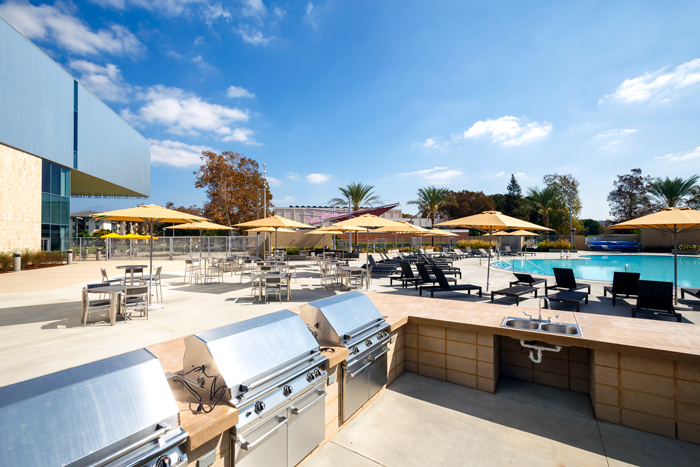Why do we frequent a favorite restaurant? That seems like an easy answer—it’s because we love the food. And while that’s likely the case, there may be other factors at play. Maybe the atmosphere and décor are extra pleasing, or the location and view. We might adore the staff, and appreciate the efficiency and cleanliness. Perhaps they have live music or great specials—things that keep us coming back. Conversely, even if we love the food, the place might leave a bad taste in our mouth if some of those other features are lacking.
The same could be said for many types of businesses, and aquatic facilities are no different. Sure, we mainly just want to get in the water, whether for recreation, fitness, competition or therapy. But oftentimes it’s the non-water features that keep us coming back: clean and modern restrooms and locker rooms; easy parking and accessibility to the water features; food and beverage options; comfortable places to sit and relax; things to occupy the little ones when they’re not in the water.
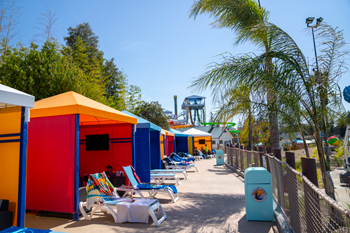
“Designing appropriate support spaces is paramount to ensuring your guests spend a full and enjoyable day at the aquatic center,” said Jen Gerber, vice president, strategic partnerships and operations at Water Technology Inc. “Offering concessions, gender-neutral or family change rooms and considerable deck space and shade for lounging and relaxing is very impactful on the guest experience.”
She explained that the user experience at an aquatic facility is often dictated immediately upon their entrance to the facility. “The easier it is for guests to find ample parking, lounges/chairs, lockers or space to set up camp for the day, the more likely they are to stay and enjoy the amenities.”
“What we are seeing now is a shift of attention toward support and periphery spaces to maximize user comfort,” said Lauren Ozburn, aquatic consultant and project manager at Waters Edge Aquatic Design. “Shade opportunities, enhanced seating options, technology integration through Wi-Fi and on-deck outlets, and universal restrooms are all of interest to communities.”
“Shade, comfortable seating options, and even dry amenities such as televisions, lawn games such as bocce ball, pickleball, oversize chess boards, volleyball and shuffleboard are also starting to increase in popularity as aquatic centers shift their focus toward keeping the entire family entertained, especially in places that sell food and beverages,” said Justin Caron, principal and CEO of Aquatic Design Group. “Strong Wi-Fi and point-of-sale technology are also being utilized in public sector facilities as a way to reduce wait time, contact, and enable patrons to stay productive. Some of these also include data tracking ability and even advertisements to help offset the associated costs.”
Even basic pool deck seating has gotten more comfortable these days, with more loungers, tables, tasteful shade features, etc. And rental cabanas continue to be extremely popular. “We see our large entertainment waterparks benefiting from rentable space like cabanas, which can be offered at differing levels of benefit and at various price points to fit the needs of all guests,” said Gerber. “Resorts like Kalahari will fill their indoor and outdoor areas with cabanas and they continuously sell out, providing significant revenue generation, above and beyond the standard rates.”
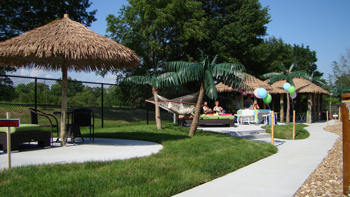
Rentable seating spaces like cabanas run the gamut, from plush tents with couches, flat screens and personal wait staff to simple shade and chairs. David Keim, director, public market business development at Aquatic Development Group, pointed out that cabanas are gaining popularity in community aquatic centers too, “as guests are seeking a space of their own for the day, as well as a premium experience. With some parks offering cabana food and beverage service, the revenues that may be derived from increased F&B purchases and cabana rental fees can have a significant impact on revenue generation.”
Chris Nawracaj, general manager of Deep River Waterpark in Crown Point, Ind., operated by Lake County Parks, said that they have three eight-person cabanas and five that hold 12 people, located in two areas of the park, each area with an attendant. Groups reserving them check in at the group sales office, where they’re given wristbands granting them access to their cabana area. “They’re extremely popular for us, and we currently don’t have enough of them. Even on marginal weather days, when the park isn’t as crowded and there’s plenty of available space, they generally sell out.”
The cabanas look like little houses, and Nawracaj said they build them themselves, from scratch—a team effort. “It’s one of my favorite things to do. We had originally looked into more of the tent-style ones, however in the end we figured that the tiny house ones would hold up better. If a group orders off our catering menu in advance, we’ll deliver it to their cabana when they want it to arrive.” He said they’re looking into adding mobile ordering.
Deep River also has two gazebos and a pavilion, rentable for private gatherings. “The gazebos hold up to 75 people and are popular with family reunions, larger birthday parties and smaller corporate groups. The large shelter holds 200 people and is mostly popular with large family outings and bigger corporate events. If either the gazebos or large shelter aren’t rented for the day, they are open to the general public to use,” said Nawracaj.
“Community recreation facilities will tell us that there is no such thing as too much rentable space,” said Gerber, who pointed out that facilities of all sizes are getting into the game with rental revenue. “At the Clarksville Cove Aquatic Center (Clarksville, Ind.), the renovation of their birthday party area and the addition of more rentable space led to a 263% increase in birthday party attendance. Revenue generation like this is significant in the ultimate goal to maximize participation and to offset operational costs.”
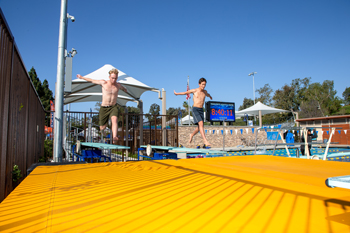
In St. Charles, Ill., Otter Cove Aquatic Park is operated by the St. Charles Park District. It features a lazy river, lap pool, activity pool and toddler pool. There’s a slide tower with various waterslides and a splash park. Alex Hartzell is the aquatics and youth programs supervisor with the park district, and she said birthday parties are held nearly every day at the park. “We allow visitors to decorate the rental areas. We do not offer packages; they plan and execute the party themselves, and we just provide the space and fun,” which sometimes means a visit from Ollie and June, the park’s mascots.
Otter Cove has small and large pavilions—capacity 20 and 50—that can be reserved in advance. If a rental space is open, guests can reserve on the spot using a QR code. Users typically cater gatherings themselves, though if they order food in advance, it can be prepared by concessions staff. There are also two cabanas and three suites located throughout the park. “Currently each reserved area has either couches or tables and chairs that are included,” said Hartzell. “We are hoping to begin mobile ordering this summer for our daily rentals.”
Six rentable shade shells are also scattered around the park, each featuring two lounge chairs under a half-shell canopy. And there’s a bridge over the lazy river leading to a grassy island in the middle. “Our Lazy River Island is a great space to escape,” said Hartzell. “With just the noise of patrons in the lazy river, the island allows you to spread out a little more and snooze under our three shade umbrellas.” There are also rentable river shade areas, accommodating up to 10 people with comfy chairs and shade sail structures. And there is plenty of other first-come, first-serve seating around pool areas.
Spraygrounds and splash pads have been popping up in all kinds of locations in recent years, oftentimes where pools are not feasible. But there’s been a trend to add these features to pool decks or adjacent areas as well. Melinda Pearson is a design and specification manager with a Kelowna, British Columbia-based splash pad and waterpark equipment manufacturer. She said that one trend has been to remove separate toddler pools or large bodies of beach entry water and replace these with splash pads. “These also don’t require guarding when there’s no standing water, and with the challenge of hiring lifeguards this has been a fast trend we’re seeing. Sometimes these splash pads are designed to be used during the ‘shoulder seasons’ (spring and fall) when the pools are closed.”
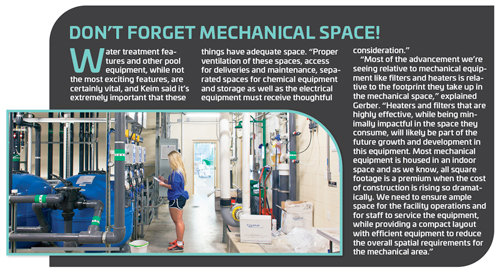
These features are also showing up at indoor aquatic facilities. “When we propose features for an indoor pool a trend we’re seeing is adding in more social areas,” said Pearson. “This may include features that are multipurpose (such as restorative sprays that can be used as a water therapy massager and play element) or areas in a zero-depth beach entry where guardians can play with younger children and still observe their older children in the facility.”
She advised that whether adding features or an activity tower, they need to be designed to not block lines of sight, as natatoriums typically have less workable space. “Wall-mounted and deck-level sprays are popular features to make the best use of space, and proper sloping and drainage is necessary to eliminate too much water on the decks.”
Otter Cove has a spray park with three separate splash pads that cater to different age groups, and Hartzell said it’s very popular. “With no standing water, children can run from splash pad to splash pad.” Technologies continue to advance with water management systems, including Wi-Fi-capable Smart controllers, high-efficiency manifolds and on-demand activators. Features can come with attach-and-detach anchoring systems to easily swap them out. Hartzell said they’re re-doing their system next fall. “We’re excited to update the splash pads and piping as well as add new features within.”
Another favorite feature in the splash park area that Hartzell mentioned is the sand play area, which is covered by two shade umbrellas. “Many kids—and parents—spend hours in our sand pit building castles and moats. Sand toys are offered but you can also bring your own.”
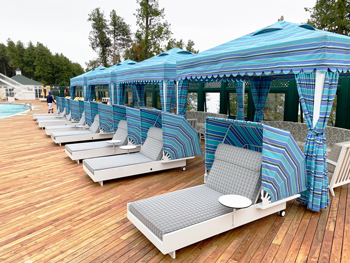
In fact, there’s also a sand volleyball court within the park. “Volleyballs are free at the manager’s office and sometimes our mascots or some lifeguards like to get out there and play!”
When it comes to visitor comfort and happiness, offering accessible and modern restrooms and locker rooms is a critical consideration for facility operators, and convenience is certainly important as well.
“With diverse programming the demands of locker and changing rooms has evolved,” said Caron. “Space for teams, seniors and children must be accounted for. All-gender facilities have become a standard at modern facilities. Attention to spaces that can be monitored for safety as well as safe egress in emergencies must also be provided for.”
At Otter Cove, “Locker rooms are scattered throughout the park,” said Hartzell. “We have locker rooms in our main lobby as well as two all-gender family bathrooms and then another set of bathrooms at our splash park.” And one popular amenity she mentioned was their swimsuit dryers. “You can hear the dryers going all day long—a great way to not bring home a wet suit.”
Over at Deep River, Nawracaj explained that their locker rooms offer men’s, women’s and family options. “Each of the bathrooms do have private changing stalls as well.” And there are also separate locker areas—not in the locker rooms—available with full-day, unlimited access. Users can pay with a credit card at two kiosks, then they’re assigned a locker number and can set up their own locker code. Standard, large and jumbo sizes are available. “As the park expanded along with the need for more lockers, it became its own standalone thing; it made it easier on us operationally.”
Let’s face it—people love to eat and drink. And if the goal is to keep guests around for longer periods of time, then offering food and beverages is an important part of this strategy. Keim said that concessions are an important consideration for every project. “Ensuring that there are adequate food and beverage outlets, with the right mix of offerings, to quickly serve guests, is a very important consideration. As parks continue to up their game in F&B offerings, and guests demand quick service and short wait times, paying attention to F&B design is of utmost importance. Municipal parks are even beginning to offer adult beverages in some parks with beer, wine and frozen drinks being offered.”
Indeed, aquatic facilities of all sizes have ramped it up with food and beverage offerings, unlike the old days of just popsicles and pretzel rods. Nawracaj said they have “extensive food and beverage offerings with stands that sell burgers, hotdogs, chicken, funnel cakes, pizza and of course, Dippin’ Dots. They greatly help out with revenue for the facility and are all quite popular with the customers as well. Last season our per cap on food and beverage was just over $4, so enough to make a difference on the bottom line.”
Pearson said that she’s seeing a lot of food trucks, particularly at outdoor aquatic centers and splash pads. “Municipalities get the rental fees but not the overhead of operating these. It also helps keep the families at the park all day.”
Deep River allows coolers in the park, according to Nawracaj, “since the very beginning and we’ve kept it to this day for a marketing point, to set us apart from others, and as a parks department-owned facility, it makes us more family-friendly.” He said they have people inspecting coolers prior to entry to make sure they don’t have items that aren’t allowed—glass, knives or alcohol.
At Otter Cove, Hartzell said that quite a few visitors bring in their own food, as this is also allowed there. “There are specific eating areas scattered throughout the park.” There’s also a concessions building with outdoor seating, The Dive. “Concessions have gotten better and better each year. Staff have created an efficient process and great team environment to work as quickly and effectively as possible. New this year is a point of sale system that better suits our patron’s needs.”
At Otter Cove you can also grab some pool necessities if needed. “We try and market what items we have for sale at our front desk, which includes swim diapers, towels, goggles and sunscreen,” said Hartzell.
At Deep River there’s a Surf Shop, and Nawracaj said this also helps out with revenue. “We have a rather large gift shop that sells just about everything from toys, swimsuits, towels and sun care products to logo merchandise. It’s a great place to stop by and get something to remember your visit by.”
And making sure these memories are positive is the number one goal for facility operators and planners. Adding fun and exciting non-water features is important, but accessibility, convenience and comfort are also crucial considerations to entice visitors back, and offering “thoughtfully designed support spaces,” according to Gerber. “The pool may be the main attraction, but a facility’s success stems from its ability to accommodate the identified bather load comfortably. Important to any functional and safe design is parking, universal bathrooms and locker rooms, shade and adequate space for food and beverage.” RM



